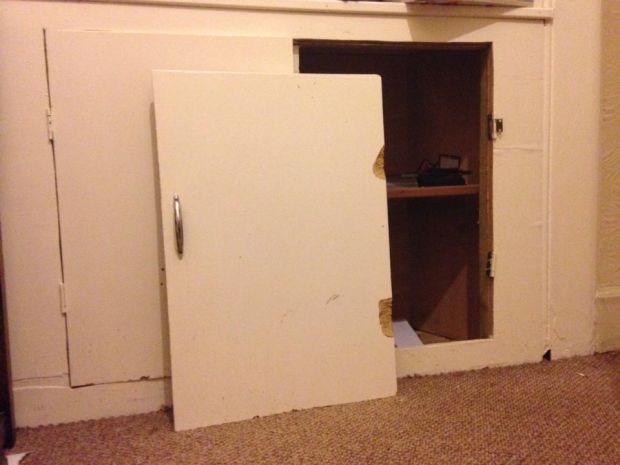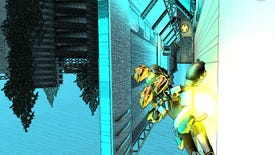Wot I Think: Cloudbuilt
Rising star or race to the bottom?
Cloudbuilt, from new kids on the block Coilworks, is more speedrun challenge than regular game. Its jetpack-equipped heroine double jumps and wall-runs her way through a series of dreamscape arenas, dodging laser beams, mines, turrets and deadly falls into the abyss. It's frustrating, difficult and confusing in equal measure, but could easily top game of the year lists for a certain crowd. Gorgeous and deadly, here's Wot I Think.
At time of writing, the casualties of Cloudbuilt include one pen, most of the feeling in my right hand, my temper and a cupboard door. It certainly has the “enraging me to the point of senseless violence” bit of being a speed-puzzle-platformer down. Once I’ve wiped away this red haze of childish emotion, I might be able to bring myself round to some critical thought. In the mean time: fuck this brilliant bullshit.
Deep breath. Okay.
To deconstruct that four word tirade slightly: when Cloudbuilt is good, it's very, very good. I get a lot out of just looking at the damn thing, as its beautiful cel-shaded art style is a real joy. The gritty, cartoon-ish shading makes the floating cubes seem strangely more believable and the scattered enemies more deadly. In a game where split-second recognition is so vital, both platforms and foes being immediately distinguishable is a necessity. Surveying a level from a high spot or planning a route feels good when the draw distance is cranked all the way up, and I was rarely surprised by a background-camouflaged antagonist.
Those routes are impressive designs by themselves. Each level has scattered checkpoints that save your progress - and time - should you fall or be slain, but there are many different possible trails between them. Some are simply scattered platforms that can be picked through in any number of ways, with different fuel (for the parkour-allowing jetpack) and health (for, uh, surviving) pickups scattered between them. A straight line may seem quicker at first, but going this way, then over here, may allow the boost to be used to cross gaps and put you in less danger. It's a puzzle to be solved twice, at first simply to progress and then later to climb the leaderboards. Others are more complicated: branching series' of fights, climbs and wall-runs that eventually converge further along the level. It's not necessary to pass every checkpoint, so long as the final door is reached, making beginner and expert routes totally different.
It can be overwhelming - and a pre-map familiarisation swoop rather than the current snapshots of random parts of the level wouldn't go amiss - but the exploratory element can't be overlooked. The amount of power at protagonist Demi's fingertips is extreme. With ample fuel picks ups she can sprint vertically, jet forwards with uncontrollable haste or maintain a wall-run indefinitely. Picking options on the fly or analysing the environment for a few moments will produce wildly different results. At one stage I didn't fancy the look of a particularly difficult section of interior climbing, so began a series of experimental jumps to just-out-of-reach platforms. After a few failed attempts I discovered an entirely separate way to climb the outside of the building and jump down onto its roof from high above. Of course, then I was surrounded by the enemies I hadn't killed on the ascent, producing a desperate firefight and dodge session to the next checkpoint.
This moment felt emergent, because I discovered it myself with no prompting other than not wanting to go in the assigned direction. A slyly hidden extra life was present on the way, a nice reminder that I hadn't broken the game but was somewhere determined by the designers. These are used as a cap on the number of retries you receive from a single checkpoint and are probably the best implementation of limited lives ever. Better times give you more, making later levels easier, so there's reason to replay beyond grinding your way up a leaderboard. There's at least one of these on every map, but I only found two in my playthrough of most of them. Hopefully this indicates that they are stealthily placed, and not that I'm just terrible at the game.
Because, hand on heart, Cloudbuilt kicked my ass. Not in the Super Meat Boy "man I might need to take a second crack at this" way or the Veteren difficulty Call of Duty "eventually I'll be quick enough on the draw" way. In the "I've been screwing up this one jump for ten minutes" N way, only in every level, not just the later ones. In the "fuck you, you're going to sit down and learn a whole new skillset" Dark Souls way. Cloudbuilt demanded attention, time and effort, with a healthy dose of physical dexterity and planning on top. There were times when the space between checkpoints would hold two or three challenges with split-second timing requirements and masterful resource management.
And that's just to finish a level. Never mind optimising through the wall-running, bullet-dodging, laser-jumping hellscape that is each new bloody gauntlet. Never mind the selection of challenge modes that allow for play under even more difficult restrictions. Or the seemingly impossible later maps I still haven't completed. Raaaaaargh!
Deep breath.
My door-kicking anger with Cloudbuilt stems mostly from a lack of control. The pace with which Demi will move when I'm just mildly jabbing at a key without any jetsistance, is ridiculous. Which is awesome, because not nearly enough game characters seem to understand I'm playing a god damn video game and they need to hurry the hell up. Press shift to ignite your way forward and it's positively ludicrous. Which is awesome. However, combine the two with a time limited nature and requirements on jump angle deciding whether I get the wall-run I was after or the wall-climb I was not - with no way to switch between the two - and you quickly get the above. At one point the fiddliness of it convinced me I was meant to be playing with a controller, only to plug one in and find that support was yet to be implemented. I don't think these actual mechanics are the problem, it's more an issue of a poorly developed difficulty curve (stemming from the commendable commitment to four totally different mission paths) that introduces new elements very regularly and doesn't provide any time to learn. You'll beat an area once and the next won't build on it in any meaningful way, just provide some new insanely difficult challenge.
The enemies echo this lack of teaching. There's no description for any of them, meaning it's a see and react, trial-and-error approach for each. This wouldn't be much of a problem if their reaction was consistent. Some turrets can be destroyed, while others are blissfully invulnerable, while still others shield themselves from all harm and stop firing after a certain amount of damage. There are small robots on the ground which sometimes react with a shield, while at other times just shut down. Perhaps there's some system behind their "choice" but I couldn't see it, and there's no time to stop and observe for long.
And yet that still would be fine if the enemies weren't just so antithetical to what is enjoyable about the game. All damage slows, knocks back and prevents air movement. Some home in on you, giving the feeling of being chased, but never hit into surfaces and take too many shots to die. The skittering ground robots, as discussed above, can't even be cleared out before heading onwards, as their shield eventually dissipates and they deal damage again. I don't want to stop moving; it's the main appeal of the game, so nothing should take me out of that state bar death. I don't want to reject all opposing force out of hand, in fact it's the ones that act as effective blockages - mines that either knock Demi into the abyss or do so much damage as to kill her immediately - that I mind the least. Retrying a section that requires precise timing is fine, it's dealing with unpredictable moving elements that is the issue.
The amount of firepower positioned against you does rather interact with the plot of Demi being the survivor of a bomb blast that took out her squad in a non-descript war. It's an odd game to use for a horrors-of-combat type message and the depressing, self-reflective audio logs that accompany the end of each level do rather put a downer on the whole scenario. I don't think the story itself is bad, and it branches as much as the mission structure, with a number of distinct endings and interpretations, but the transmission of it is. There's no interaction with, or even really representation of, the plot in the main game, just the unlocking of more reasonably acted dialogue. A cool experiment, but not something that registered particularly.
Yet, for all these faults, for all the frustration and hurting toes it's brought me, the feeling that lingers after playing Cloudbuilt is a sense of accomplishment. Beating a level you've been trying for half an hour, an hour, three, is fist-pumping, arm-raising, Daniel Bryan-tier elation. Perfecting a run through a segment, free-flowing from wall-run to jump to climb to blast that enemy is pure joy. It will make you believe you are a god, the time spent swearing and feet-stamping slipping away. I can only imagine how it feels to shave a completion time to within an inch of its life and top the leaderboard - but I'll go with "gamegasm."
For a certain crowd of challenge gamers and speedrunners, this is your new devotion. You'll laugh and cry and swear and, I hope, create works of beauty through world records and live runs. For the rest of us, you'll need to judge whether the incredible style, absolutely extraordinary soundtrack and stellar highs are worth the lows that will make you want to snap your keyboard in half.
You can grab Cloudbuilt, and read its ace "most helpful review" on Steam for £14.99.













